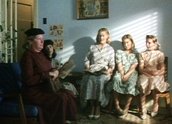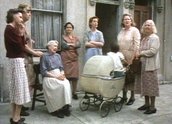


Poor Man’s Orange (1987)
Synopsis
The story begins just a few years after the end of Harp in the South and continues the story of the Darcys, an Irish-Australian family, and their local community in Surry Hills, after the Second World War. It is a time when the inner-city, for so long the domain of sly grog shops, bawdy houses and a refuge for country people down on their luck, is about to be transformed by gentrification.
Roie Darcy (Anna Hruby) is married to part-Aboriginal Charlie (Shane Connor), whose resentful mother-in-law fears his 'dark blood’ will be visited on her grandchildren. The couple are always looking for somewhere to live, nearby but separate from the family. However, rents are prohibitive and there is a housing shortage. There’s a second child on the way adding urgency to their quest.
Roie’s father, Hughie Darcy (Martyn Sanderland) has been seeing a local prostitute who is bleeding him of any spare cash. His wife Mumma (Anne Phelan) wonders what she can do to compete with this younger, more attractive woman. Then Roie’s pregnancy goes tragically wrong and the family are forced back upon themselves. The youngest in the family, Dola (Kaarin Fairfax), must give up school. She grows up quickly, finding a role at the centre of events, becoming the new linchpin of the family.
Curator’s notes
The title Poor Man’s Orange refers to having to make do with second best. This is the choice facing Dola after her sister’s death. She is prepared to follow in the footsteps of her beloved sister and marry Charlie although she realises she can never replace Roie for Charlie. It’s a very different sort of love which will sustain her in her new life, a sort of poor man’s orange 'with its bitter rind, paler flesh and stinging, exultant bitter tang’ to quote Ruth Park’s words in the novel.
When the first of the two miniseries, Harp in the South was still in the cutting room, it was so admired by Network Ten’s then head of drama Valerie Hardy that she immediately commissioned this second series. This time George Whaley both adapted the book and directed the series.
Producer Tony Buckley says that this sort of miniseries could no longer be made. The Surry Hills streets are now gentrified and it’s unlikely a production could get permission for such long-term street closures that enabled the shooting of these series. Tony is proud that no CGI (computer generated images) were used in the production.
- Overview
- Curator’s notes
- Video 3 clips

- Principal credits
- Find a copy
- Make a comment
- Map
- Add your review



